Menu
Close
Back
Welcome to
Together is a new resource for anyone affected by pediatric cancer - patients and their parents, family members, and friends.
Learn MoreHearing loss is a possible side effect of some pediatric cancers or cancer treatments. Certain cancer medicines and other treatments, including radiation and surgery, can damage the ear, resulting in hearing loss. In some cases, hearing loss may develop due to the tumor itself.
Children who receive ototoxic therapies (treatments known to cause ear damage) should have regular hearing tests to watch for problems. Hearing loss can affect speech, social relationships, learning, academic achievement, and career goals. Early assessment and intervention can help patients and families better manage hearing loss to promote quality of life after cancer.
In some cases, the care team may recommend changes to medicines or other treatments based on hearing loss.
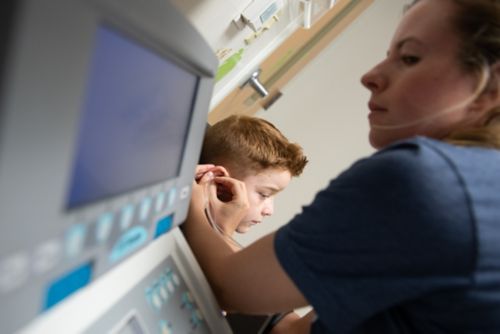
Children who receive treatments known to cause ear damage should have regular hearing tests to watch for problems.
Find more information on hearing and communication in babies and young children.
Risk factors for hearing loss in childhood cancer patients include:
Receiving treatments at a younger age and/or more intensive dose of chemotherapy or radiation also increases the likelihood of hearing loss.
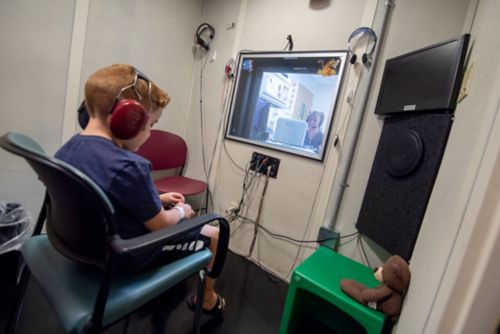
Ototoxic medicines, drugs that can damage the ear, can result in hearing loss. Hearing loss may also be caused from the effects of the tumor. Regular hearing tests can help identify any developing problems.
There are three main parts of the ear:
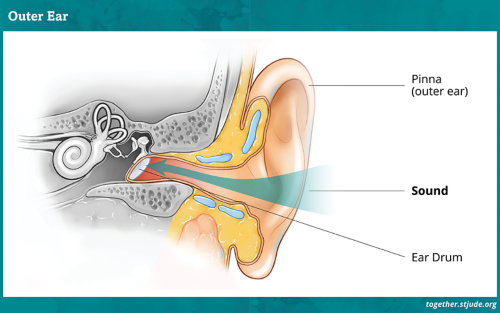
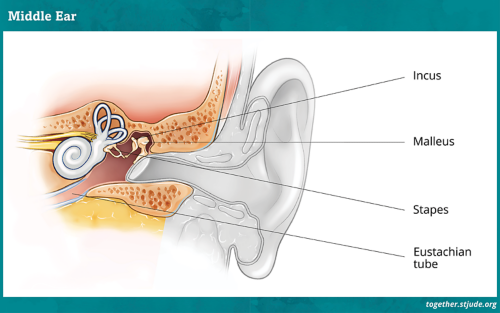
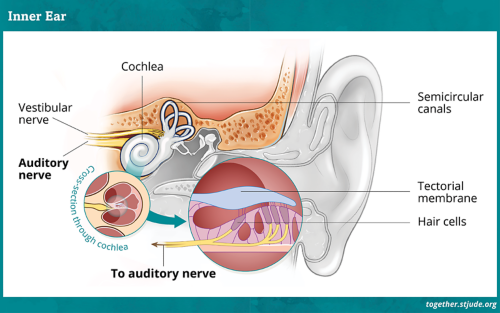
Different types of hearing loss may be seen childhood cancer patients and survivors. Hearing problems due to chemotherapy are likely to affect both ears. However, hearing loss after surgery or radiation may be in one or both ears, depending on the specific type of damage. For some patients, hearing may improve over time. For many patients, hearing loss is often permanent and may get worse with age. Some survivors may start to have hearing problems months or years after treatment ends. These problems are known as late effects. Understanding the type of hearing loss is important to help in planning care and monitoring.
Conductive Hearing Loss
This type of hearing loss when there is blockage or damage in the outer or middle ear. Fluid, wax, or swelling may prevent sound from traveling normally, causing sounds to seem “muffled.” The eardrum or bones of the middle ear may also be stiff or damaged. Infection can be a common cause of conductive hearing loss. Radiation therapy may also cause conductive hearing loss in one or both ears.
Sensorineural Hearing Loss
Sensorineural hearing loss results from damage to the hair cells of the inner ear (sensory) or to the auditory nerve or brain (neural).
Hearing loss in pediatric cancer patients may be conductive, sensorineural, or a combination. Conductive hearing loss may improve over time if the cause of the problem, such as fluid or swelling is removed. Sensorineural hearing loss is likely to be permanent, especially if hair cells or nerves have been damaged by chemotherapy or radiation.
Patients at risk for hearing loss should have hearing tested by an audiologist. A common type of hearing test is an audiological evaluation in which the patient listens to different sounds through earphones. The audiologist records what sounds and pitches can be heard for each ear. The results are recorded on an audiogram and compared to the levels expected for normal hearing. This test is also used to monitor hearing over time. Hearing can also be tested by monitoring brain waves in response to sound. This test is called an Auditory Brainstem Response (ABR). Based on risk factors and hearing loss symptoms, the audiologist will recommend follow-up testing and monitoring.
A variety of services and assistive devices are available to help with hearing disorders. These include:
An audiologist can help match patients with the best services and devices to fit their needs. It is important that parents make sure that children use their hearing devices properly and keep follow-up appointments to monitor hearing. Hearing loss is associated with problems in different areas including school, work, and relationships. However, being consistent with wearing hearing aids or other devices and using available services (such as Individualized Education Plans – IEP) can help give children the best chance for success in life after cancer.
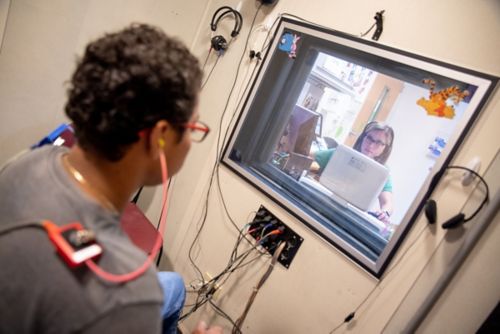
Regular hearing tests can help identify any developing problems. An audiological evaluation is a common type of hearing test in which the patient listens to different sounds through earphones.
Know your risk. Talk to your care team about cancer treatments (including dose received) and other risk factors for hearing loss.
Get tested and watch for symptoms. Have a baseline hearing test and get regular monitoring to catch hearing changes early. Symptoms of hearing loss can be easy to miss. Be aware of what to watch for and report any concerns to your doctor or audiologist.
Use hearing assistance devices and services. Some of the negative effects of hearing loss can be prevented by using appropriate devices and services. Make sure you meet with the audiologist regularly and follow recommendations.
Protect your hearing. Everyday noise can damage hair cells of the inner ear. Loud sounds can damage hearing quickly, and even lower volumes can cause damage over time. Take care to limit exposure to loud sounds such as music, traffic, sporting events, and lawnmowers or construction equipment.
Here is a quick list to help you talk to your doctor about risk for hearing loss. Children who receive cisplatin, carboplatin, or radiation to the head or neck should have hearing tested at least once after completion of treatment with follow-up testing as recommended.
| ✔ | Risk Factor |
|---|---|
| My child received cisplatin or carboplatin chemotherapy. | |
| My child received radiation therapy to head or neck. | |
| My child received aminoglycoside antibiotics (amikacin, gentamicin, tobramycin) or erythromycin. | |
| My child received certain diuretics such as furosemide or ethacrynic acid. | |
| My child was under 4 years of age when cancer treatments started. | |
| My child has other risk factors such as preterm birth, low birth weight, prior hearing problems, repeated ear infections, meningitis, scarlet fever, or poor kidney function. |
Survivors of childhood cancer who have risk factors for hearing loss should have yearly check-ups with their primary doctor and make sure that hearing screens are part of regular follow-up care.
—
Reviewed: August 2018